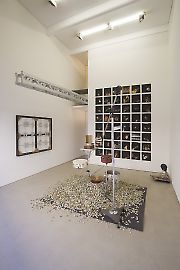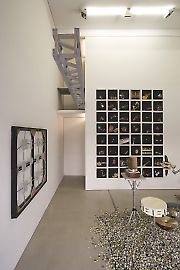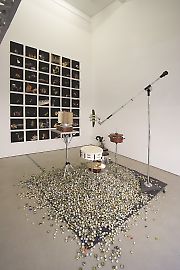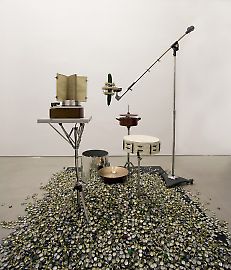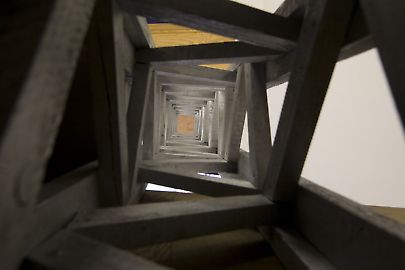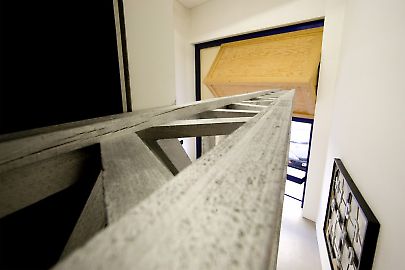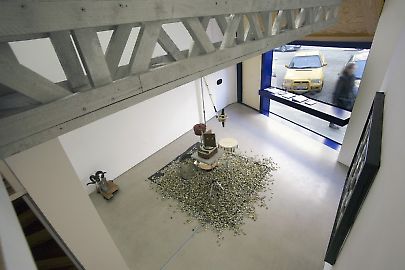Michael Gumhold -- [: Rehearsal : Room #20 :]
Hangover! The gig’s over! End of the party! In the rehearsal room, the remains of a night of excess: beer bottle caps all over place, inside the amplifiers and around them, scattered across an improvised stage. A stage element juts out from the balcony parallel to the wall. A cucumber is placed in a microphone stand, while its dripping juice is collected by an upside down cymbal. The intensity of the debauchery that apparently preceded is palpable, in its reverberations the remembrance of a physically experienced unbridledness and excessiveness.
In [: Rehearsal : Room #20 :], his second solo show at Georg Kargl, this time at BOX, Michael Gumhold refers to the affective directness of the performative power of music and again to a rather hard edged variety of rock. As in his other Rehearsal Room installations, components are shifted in their functions and aspects of meaning: empty containers, heaters, or pots become musical instruments, springs stretched across pictorial objects refer to sound vibrations, beer bottle caps replace the zills of a tambourine, and recording devices become devices that generate sound. Divorced from the original functional context, instruments find a new existence in the sign system of art as sculpture. His installations are a continuous series of arrangements and rearrangements that just as in music set different accents by way of their style and form. Music itself remains silent in the rehearsal: room installations, yet its emotional potential is revealed with all its intensity in the setting of the exhibition.
All the same, ruptures in the turn toward excess also reveal themselves, as Gumhold ambiguously points out in his text-image objects. The syllable “-phonie” can be read as a homonym of “phony.” The letters M-I-C-R-O-P-H-O-N-I-E-S dance blithely, held by springs in the frame, themselves posing the question of authenticity.
With the work Untitled (equipment, hands, instruments, 2011–12), Michael Gumbold expands his system of references temporally and stylistically. On a series of record covers, he covers everything that makes these images incomparable and outstanding using black paint. Backgrounds, pictures, titles, names, indeed the musicians themselves are thus omitted. He only leaves behind the instruments, microphones, and the hands playing them or holding them. Looking at what’s left, it’s immediately clear that they are not contemporary covers. The colors, the style of representation, and of course the fact that the instruments are analog are clear clues. Gumbold directs our attention to what is required to generate sound, resonating bodies and hands. The result, stored on sound media, is what remains of the event. The soundless performances on the record covers evoke a silent orchestra, an imaginary euphony or cacophony. A feeling of morbidity creeps into the arrangement of [: Rehearsal : Room #20 :]. A question of emptiness that remains after the excess: Can the euphoria be preserved? The horned foot machine hammers against the wall silently: with no resonating bodies, there are no vibrations.
Text: Linda Klösel
Translation: Brian Currid, zweisprachkunst.de


